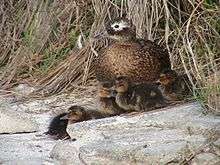Minimum viable population
Minimum viable population (MVP) is a lower bound on the population of a species, such that it can survive in the wild. This term is used in the fields of biology, ecology, and conservation biology. More specifically, MVP is the smallest possible size at which a biological population can exist without facing extinction from natural disasters or demographic, environmental, or genetic stochasticity.[1] The term "population" rarely refers to an entire species. For example, the undomesticated dromedary camel is extinct in its natural wild habitat; but there is a domestic population in captivity and an additional feral population in Australia. Two groups of house cats in separate houses which are not allowed outdoors are also technically distinct populations. Typically, however, MVP is used to refer solely to a wild population, such as the red wolf.
Estimation
Minimum viable population is usually estimated as the population size necessary to ensure between 90 and 95 percent probability of survival between 100 and 1,000 years into the future. The MVP can be estimated using computer simulations for population viability analyses (PVA). PVA models populations using demographic and environmental information to project future population dynamics. The probability assigned to a PVA is arrived at after repeating the environmental simulation thousands of times.
For example, for a theoretical simulation of a population of 50 giant pandas in which the simulated population goes completely extinct, 30 out of 100 stochastic simulations projected 100 years into the future are not viable. Causes of extinction in the simulation may include inbreeding depression, natural disaster, or climate change. Extinction occurring in 30 out of 100 runs would give a survival probability of 70%. In contrast, in the same simulation with a starting population of 60 pandas, the panda population may only become extinct in four of the hundred runs, resulting in a survival probability of 96%. In this case the minimum viable population that satisfies the 90- to 95% probability for survival is between 50 and 60 pandas. (These figures have been invented for the purpose of this example.)
MVP and extinction

MVP does not take human intervention into account. Thus, it is useful for conservation managers and environmentalists; a population may be increased above the MVP using a captive breeding program, or by bringing other members of the species in from other reserves.
There is naturally some debate on the accuracy of PVAs, since a wide variety of assumptions generally are required for future forecasting; however, the important consideration is not absolute accuracy, but promulgation of the concept that each species indeed has an MVP, which at least can be approximated for the sake of conservation biology and Biodiversity Action Plans.[2]
There is a marked trend for insularity, surviving genetic bottlenecks and r-strategy to allow far lower MVPs than average. Conversely, taxa easily affected by inbreeding depression – having high MVPs – are often decidedly K-strategists, with low population densities while occurring over a wide range. An MVP of 500 to 1,000 has often been given as an average for terrestrial vertebrates when inbreeding or genetic variability is ignored.[3][4] When inbreeding effects are included, estimates of MVP for many species are in the thousands. Based on a meta-analysis of reported values in the literature for many species, Traill et al. reported a median MVP of 4,169 individuals.[5]
Population uncertainty
Population uncertainty may be divided into four sources:[2]
- Demographic stochasticity
- Environmental stochasticity
- Natural catastrophes
- Genetic stochasticity
See also
References
- ↑ Holsinger, Kent (2007-09-04). "Types of Stochastic Threats". EEB310: Conservation Biology. University of Connecticut. Retrieved 2007-11-04.
- 1 2 Shaffer ML (1981). "Minimum population sizes for species conservation". BioScience. American Institute of Biological Sciences. 31 (2): 131–134. doi:10.2307/1308256. JSTOR 1308256.
- ↑ Lehmkuhl J (1984). "Determining size and dispersion of minimum viable populations for land management planning and species conservation". Environmental Management. 8 (2): 167–176. doi:10.1007/BF01866938.
- ↑ Thomas CD (1990). "What do real population dynamics tell us about minimum viable population sizes?". Conservation Biology. 4 (3): 324–327. doi:10.1111/j.1523-1739.1990.tb00295.x.
- ↑ Traill LW, Bradshaw JA, Brook BW (2007). "Minimum viable population size: A meta-analysis of 30 years of published estimates". Biological Conservation. 139 (1-2): 159–166. doi:10.1016/j.biocon.2007.06.011.